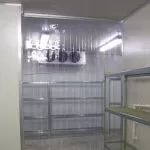Functions of Pressure Relief Vents in Walk-In Freezers
Functions of Pressure Relief Vents in Walk-In Freezers
- 07 October 2019
To an engineer, there’s nothing mysterious about a PRV (Pressure Release Valve) device. It functions as a system safety feature when potentially dangerous fluid pressures are present. If some overly compressed liquid or gas medium stresses an equipment fitting, then the valve quickly dumps the fluid. That’s all very interesting, but what do these safety devices have to do with walk-in freezers? Are there pressure build-ups happening inside a freezer? Strangely enough, just the opposite is true.
Pressure Release Vents Regulate Airborne Forces
A PRV does have a role to play as a disaster compensatory mechanism. The valves are often perceived as a final line of defence in a mains water supply. If all other inbuilt pressure regulating features fail, a pressure release valve can be counted on to safely discharge the system load. However, that’s not their only role. Active pressure relief mechanisms also regulate higher-than-average air pressures. If an atmospheric load is causing equipment stress, the kind that could cause gradual system damage and premature parts failure problems, then a pressure relief vent will act as a load regulation device.
Walk-In Freezers Develop Vacuum Seals
Back with a large freezer, a model that’s big enough to permit staff access, the atmosphere inside the sealed enclosure is shrinking, not pushing outwards. A partial vacuum develops because the cooler air in there becomes drier. Everyone has experienced this effect. On opening a refrigerator door at home, it resists your efforts. It takes a little extra muscle power to overcome the seal. When the partial vacuum is counterbalanced, the airflow equalizes. In effect, there’s a negative pressure inside the enclosure. Now imagine how much more muscle power it would take to overcome the negative pressure in a walk-in freezer. And that’s not the only problem either. After the door opens, the air in there will equalize, just like it does in a domestic refrigerator.
You’ll easily open a walk-in cooler’s door if the sealed chamber is fitted with a pressure relief vent. Even loaded down with a heavy food cart, you can probably open that door with one hand. More importantly, outside air won’t be sucked in to equalize the pressure differential. If that were the case, airborne contaminants would eventually get sucked inside. That’s a wholly undesirable and unhygienic action. More importantly, remember that the outside air is warmer than the inside air. If it were to be sucked inside by the pressure differential, the frosty enclosure would warm and the stored frozen food would spoil. With a Pressure Relief Vent performing its area equalizing duties, no contaminants and no warm air can impact a walk-in freezer’s hygienically cooled contents.
Mark Connelly
C&M Coolroom Services
E-mail : markconnelly@cmcoolrooms.com.au
Mobile: 0412 536 315


